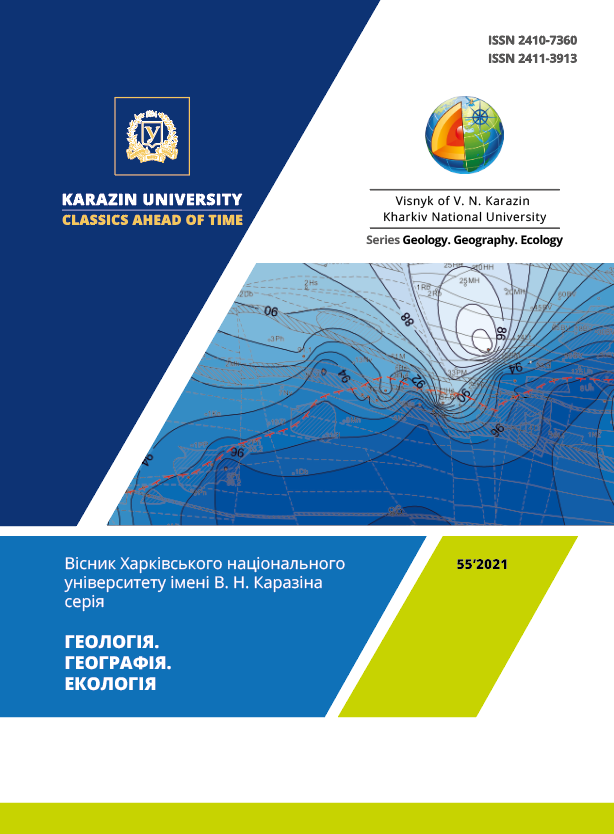Багатовимірний системний геомоніторинг підземних вод в районах водозаборів (на прикладі м. Полтава). Частина 1. Ідентифікація системного розвитку гідрогеологічного процесу
Анотація
Робота є початком серії наукових праць авторів по актуальній екологічній темі – багатовимірного системного геомоніторингу підземних вод в районах водозаборів. Авторами обґрунтована можливість застосування для геомоніторингу гідрогеологічних об’єктів методу моделювання траєкторії руху об’єктів у нормованому фазовому просторі, розробленого у Харківсько-му національному університеті імені В.Н. Каразіна для задач суспільно-географічного моніторингу. Досліджені гідрогеохімічні режими експлуатації п’яти потужних водозаборів Полтавської міської агломерації, що експлуатують сеноман-нижньокрейдовий водоносний комплекс, за 28-ми річний період часу. Кількісно розраховані по кожному водозабору наступні показники системного розвитку гідрогеологічної системи: довжина шляху, пройденого гідрогеологічною системою водозабору на кожний період часу; проекція поточної точки траєкторії на оптимальну траєкторію, відхилення точки від оптимальної траєкторії та коефіцієнт прогресу на кожний контрольний момент часу. На базі отриманих результатів моделювання встановлені основні тенденції системного розвитку гідрогеологічної системи для всіх досліджуваних водозаборів: зменшення інтенсивності зміни хімічного складу підземних вод на усіх водозаборах з часом; суттєво менші показники інтенсивності зміни хімічного складу підземних вод на водозаборі № 3; найбільша мінливість інтенсивності зміни хімічного складу у часі – на водозаборі № 1; досить помітна синхронізація інтенсивності руху гідрогеологічної системи водозаборів і середньої інтенсивності зміни хімічного складу підземних вод, але виявляються деякі відхилення від цієї закономірності, які можуть бути зумовлені різкими змінами режиму роботи водозаборів.
Завантаження
Посилання
Yakovlev, Ye. A. (Eds.) (1994). Vremennoe metodicheskoe rukovodstvo po provedeniyu kompleksnykh ekologo-geologicheskikh issledovaniy (na territorii Ukrainy) [Temporary guidelines for the conduct of integrated environ-mental and geological research (in Ukraine)], Кiev: GGP «Geoprognoz», 331. [in Russian]
Niemets, K. A., Niemets, L. M. (2014). Teoriya i metodologiya geografichnoyi nauky`: metody` prostorovogo analizu [Theory and methodology of geographical science: methods of spatial analysis], Kharkiv: V. N. Karazin KhNU, 172. [in Ukrainian]
Ognyanik, N. S., Paramonova, N. K., Briks, A. L. (Eds.) (2013). Ekologo-gidrogeologicheskiy monitoring territoriy zagryazneniya geologicheskoy sredy legkimi nefteproduktami [The ecological and hydrogeological monitoring of territories of contamination of geological environment by light oil products], Кiev: LAT&K, 254. [in Russian]
Ognyanik, N. S. (1985). Okhrana podzemnykh vod v usloviyakh tekhnogeneza [Protection of groundwater in the conditions of technogenesis], Kiev: Vysha shkola, 221. [in Russian]
Udalov, I. V., Reshetov, I. K. (2012). Ekologo-geologichne kartografuvannya ta monitory`ng geologichnogo seredovy`shha: navchal`ny`j posibny`k [Ecological-geological mapping and geological environment monitoring: a textbook], Kharkiv: V. N. Karazin Kharkiv National University, 152. [in Ukrainian]
Yakovlev, Ye. O., Mel`ny`k, I. V., Duby`cz`ky`j, A. I. (1998). Ekologo-geoximichna ocinka zabrudnennya g`runtiv, donny`x vidkladiv, g`runtovy`x vod. Metody`chni rekomendaciyi [Ecological-geochemical assessment of contami-nation of soil, bottom sediments, groundwater. Guidelines], Kyiv: DGP «Geoinform», 34. [in Ukrainian]
Yakovlev, Ye. O. (1996), Metodologiya ekologichny`x doslidzhen` regional`ny`x texnogenny`x zmin geologichnogo seredovy`shha Ukrayiny` [Methodology of ecological researches of regional technogenic changes of the geologi-cal environment of Ukraine] : Sc. D. (Technics) Thesis, Kyiv, 95. [in Ukrainian]
Yakovlev, Ye. A., Yurkova, N. A., Slyadnev, V. A. (2001), Metodologiya otsenki ekologicheskogo sostoyaniya pod-zemnykh vod [Methodology for assessing the groundwater ecological state]. Ecology and resource conservation, 3, 56-59. [in Russian]
Abtahi, M., Golchinpour, N., Yaghmaeian, K. (Eds.) (2015). A modified drinking water quality index (DWQI) for as-sessing drinking source water quality in rural communities of Khuzestan Province, Iran. Ecological Indicators, 53, 283-291. DOI: https://doi.org/10.1016/j.ecolind.2015.02.009
Aziz, A., Oudalov, I. V., Rouhollah, N. (Eds.) (2015). Rational integration of ecologic-geological studies. – Ecology, Environment and Conservation Paper, 21, 4, 1625-1631.
Chen, Y., Han, D. (2018). Water quality monitoring in smart city: A pilot project. Automation in Construction, 89, 307-316. DOI: https://doi.org/10.1016/j.autcon.2018.02.008
Dalla Libera, N., Fabbri, P., Mason, L. (Eds.) (2017). Geostatistics as a tool to improve the natural background level definition: An application in groundwater. Science of The Total Environment, 598, 330-340. DOI: https://doi.org/10.1016/j.scitotenv.2017.04.018
Kononenko, A., Lurie, A., Udalov, I. (2018). Criteria for Assessing Groundwater Contamination Levels of Marl and Chalk Water Intakes in Eastern Ukraine. Eastern European Scientific Journal (Gesellschaftswissenschaften): Düs-seldorf (Germany): Auris Verlag, 2, 13–17.
Molinari, A., Guadagnini, L., Marcaccio, M. (Eds.) (2019), Geostatistical multimodel approach for the assessment of the spatial distribution of natural background concentrations in large-scale groundwater bodies. Water Re-search, Vol. 149, 522-532. DOI: https://doi.org/10.1016/j.watres.2018.09.049
Nurani Zulkifli, S., Abdul Rahim, H., Lau, W.-J. (2018). Detection of contaminants in water supply: A review on state-of-the-art monitoring technologies and their applications. Sensors and Actuators B: Chemical, 255, 3, 2657-2689. DOI: https://doi.org/10.1016/j.snb.2017.09.078
Preziosi, E., Parrone, D., Del Bon, A. (Eds.) (2014). Natural background level assessment in groundwaters: proba-bility plot versus pre-selection method. Journal of Geochemical Exploration, 143, 43-53. DOI: https://doi.org/10.1016/j.gexplo.2014.03.015
Szabo, J., Hall, J. (2014). On-line Water Quality Monitoring for Drinking Water Contamination. Comprehensive Water Quality and Purification, 2, 266-282. DOI: https://doi.org/10.1016/B978-0-12-382182-9.00038-4
Weiwu, Y., Jialong, L., Xiaohui, B. (2016). Comprehensive assessment and visualized monitoring of urban drinking water quality. Chemometrics and Intelligent Laboratory Systems, 155, 26-35. DOI: https://doi.org/10.1016/j.chemolab.2016.03.026





